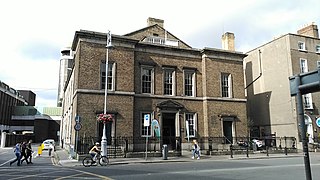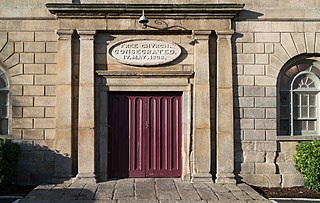Related Research Articles

The Second Great Awakening was a Protestant religious revival during the late 18th to early 19th century in the United States. It spread religion through revivals and emotional preaching and sparked a number of reform movements. Revivals were a key part of the movement and attracted hundreds of converts to new Protestant denominations. The Methodist Church used circuit riders to reach people in frontier locations.
Jonathan Smedley (1671–1729) was an Anglo-Irish churchman who became Dean of Clogher in 1724. He was an opportunist and satirical victim who engaged in a polemic with Jonathan Swift and the forces of the Tory party.

The Spanish Reformed Episcopal Church, also translated as Reformed Episcopal Church of Spain, or IERE is the church of the Anglican Communion in Spain. It was founded in 1880 and since 1980 has been an extra-provincial church under the metropolitan authority of the Archbishop of Canterbury. Its cathedral is the Anglican Cathedral of the Redeemer in Madrid.

Jesse Lee was an American Methodist Episcopal clergyman and pioneer, born in Prince George's County, Virginia. A preacher after 1783, in 1789 he visited New England and established Methodism from the Connecticut River to the farthest settlement in Maine. He formed the first Methodist class in New England, at Stratford, Connecticut, September 26, 1787. He preached his first sermon (outdoors) on June 7 or 17, 1789 in Norwalk, Connecticut. He held the first Methodist class in Boston, Massachusetts on July 13, 1792. For his pioneer work in New England he was often called the Apostle of Methodism. He was a friend of Francis Asbury, and served as his assistant from 1797 to 1800. He lacked only one vote of being elected Bishop by the General Conference of 1800, but was appointed to be a presiding elder of the south district of Virginia in 1801. He wrote A Short Account of the Life and Death of the Rev. John Lee (1805) and a History of Methodism in America (1807), which has value for the early period. On May 22, 1809, Lee was appointed Chaplain of the United States House of Representatives He was reappointed on November 2, 1812, and served for two sessions. Upon leaving the chaplaincy of the House he was appointed Chaplain of the United States Senate on September 27, 1814, where he served until December 1815.

Talbot Street is a city-centre street located on Dublin's Northside, near to Dublin Connolly railway station. It was laid out in the 1840s and a number of 19th-century buildings still survive. The Irish Life Mall is on the street.

The Molyneux Asylum for Blind Females was opened June 1, 1815 in Peter Street, Dublin, in what was formerly the residence of Thomas Molyneux (1641-1733), whose sister-in-law, Lucy Domville, had been blind. The building had been sold to Philip Astley, operating as Astley's Amphitheatre from 1789 to 1812, then the actor Henry Johnstone, intended to develop it as a theatre, however it reverted back to the Molyneux and was leased to a charity as an asylum for blind women. There was an Anglican church attached to the asylum. Music was an important part of the school and worship in the chapel. R.W. Beaty was an organist and music instructor from 1824. Henry Charles Shellard was organist and choirmaster from 1901 to 1955. The chapel was called the Albert Chapel, honoring the Queen's Husband.

Kirwan House or The Female Orphan House was a Church of Ireland-run female orphanage initially at 42 Prussia Street (1790-93), next on Dublin's North Circular Road (1793-1959) and latterly at 134 Sandford Road in Ranelagh (1959-87).

Five Ash Down Independent Chapel is an independent Evangelical church in the Reformed (Calvinist) tradition in the hamlet of Five Ash Down, East Sussex, England. Founded in 1773 in the house of a local man, Thomas Dicker senior, the cause developed so rapidly that a church was founded and a permanent building erected for the congregation 11 years later. The church was run along Calvinistic lines at first, in common with many new chapels in late 18th-century Sussex, and an early group of seceders from the congregation founded a chapel in nearby Uckfield which was run in accordance with Baptist theology. The Five Ash Down chapel has been described as "the parent of many other places [of worship] both Baptist and Independent" across Sussex, and it has continued into the 21st century—now as a small Evangelical fellowship but still worshipping in the original chapel, whose present appearance is a result of expansion and refronting during the Victorian era.

The Bethesda Chapel, Dublin, was an Episcopal Church of Ireland, church on Granby Row and Dorset Street, Dublin.
William Henry Krause (1796–1852) was a Church of Ireland priest and noted preacher.

Trinity Church, Dublin, also called the Protestant Episcopal Church, was a Church of Ireland church on Gardiner Street in Dublin, Ireland, the building of which began in 1838. It closed around 1909 and was reopened in the 2000s by an independent Christian group.

Free Church, Great Charles Street, Dublin was a proprietary episcopal chapel in Summerhill, off Mountjoy Square in Dublin.
Episcopal Chapel and Asylum for Penitent Females, was Protestant "Magdalene" asylum for "fallen women" and an Episcopal Chapel on Upper Baggot Street in Dublin. It was on the corner of Baggot Street Upper and Waterloo Road, in Dublin, the asylum could accommodate 50 penitent women and the chapel could accommodate 1,200 worshipers, it was run by a committee of benevolent donors, it was built between 1832 and 1835, it opened in 1835 and closed in 1945.
Dublin Female Penitentiary was a reform institution for "fallen women" in Dublin, Ireland. It was established in 1810 and opened in 1813. It was run by the Church of Ireland and located between Berkeley Road, Eccles Street and North Circular Road. The institution could cater for over 40 inmates.
Plunket Street Meeting House, was the site of two churches, first a Presbyterian Church, then an independent reformed faith evangelical church on Plunket Street, Dublin. It was situated between Patrick's St. and Francis St.
Irish Evangelical Society (IES), was an organisation founded in 1814 to promote the Protestant faith in Ireland. It was initially founded in London. Its aim was to support preachers and priests of the Reformed faith outside the established Church of Ireland. It was supported by a number of Evangelical members of the Church of Ireland, as well as members of the society in England. As a result, it supported Independent Ministers, priests and Chapels. It became closely aligned to the Congregationalists, and was pretty much absorbed by Congregational Union of Ireland by 1899.

North Strand Church, is a Church of Ireland church on North Strand and Waterloo Avenue, in Dublin. The original church was established in 1786. It is now part of the United Parish of Drumcondra, North Strand, and Saint Barnabas. St. Columba's National School, which was established in 1787, is on the same grounds and affiliated to the church.

Anglicanism in Spain has its roots in the 16th-century Spanish Reformation. Today it is represented by two Church bodies, namely, the Spanish Reformed Episcopal Church and Church of England's Diocese in Europe.
References
- ↑ The Early Irish Baptists Evangelical Times.
- ↑ 'Baptists in Ireland - A Condensed History of the General Baptists of the New Connexion.' By James Hurford Wood.
- ↑ 'The Church of England Magazine - Clergymen of the United Church of England and Ireland', Volume 8, January–June, published by J. Burns, London, 1840
- ↑ 'Free thoughts on protestant matters' by Rev. Tresham Dames Gregg MA, W. Curry, Dublin, 1846.
- ↑ Tresham Dames Gregg Find a Grave.
- ↑ What to do with the empty churches - Church for sale, reporter Andy O'Mahony, RTE Archives, January 7, 1979.